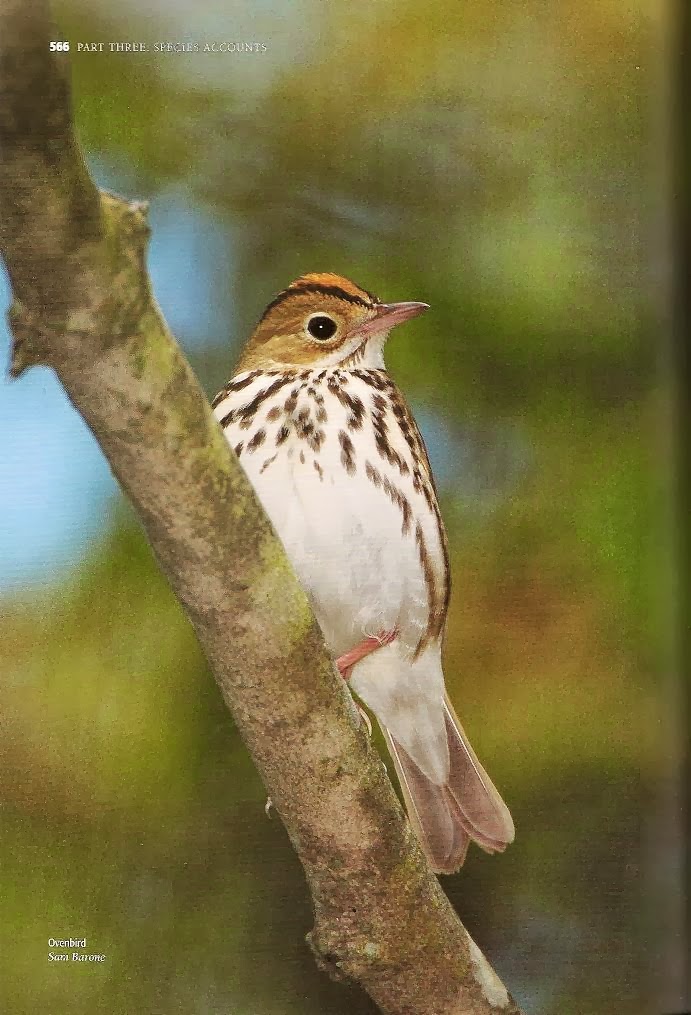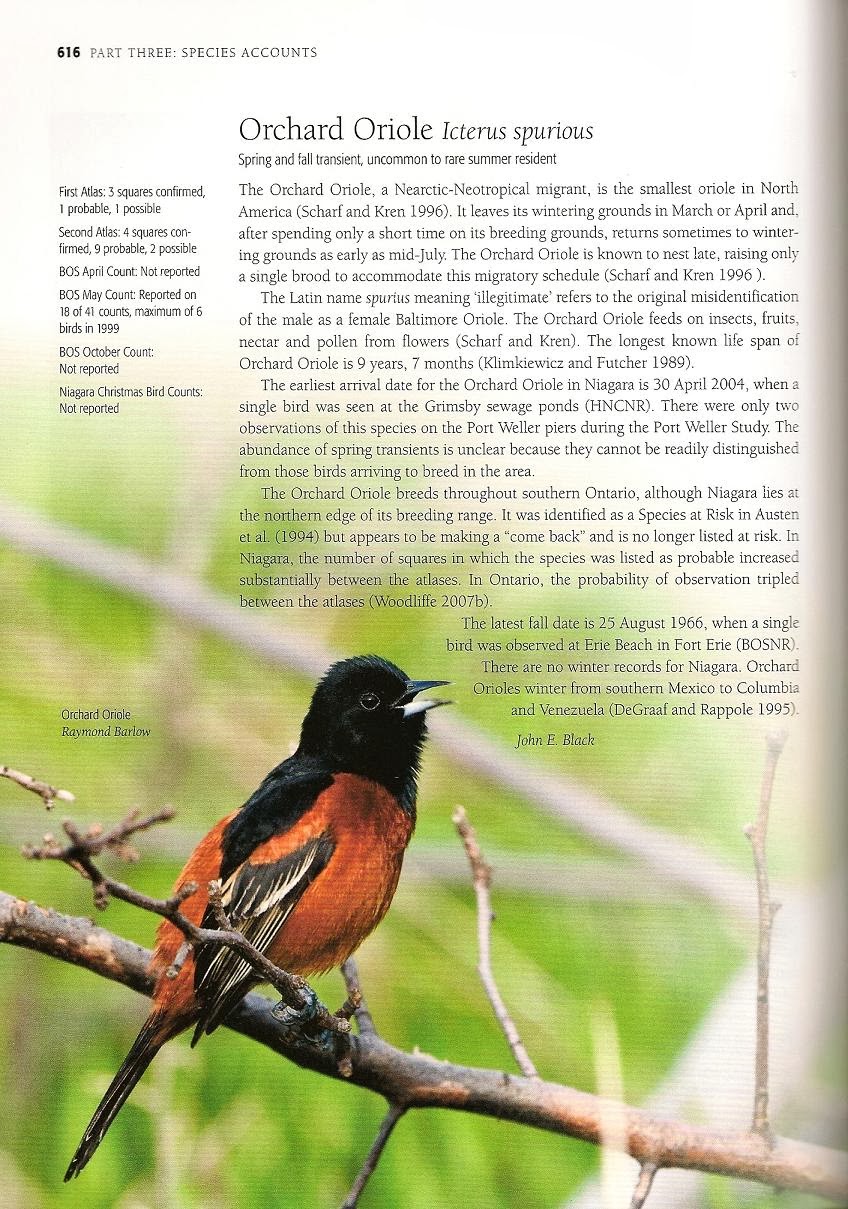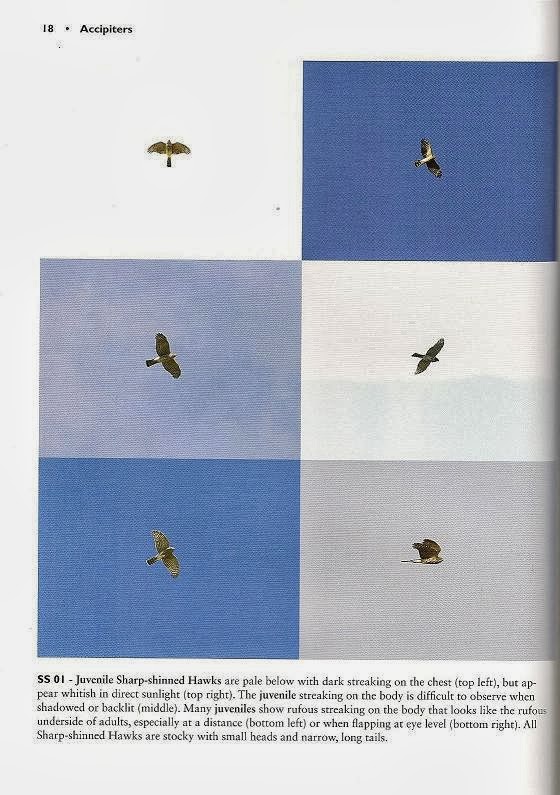Niagara Birds
by Black, John E. and Kayo J. Roy
2010, 703pp, ISBN: 9780981148908
Note: Currently, the limited supply of books is available through only the authors. You can view their website HERE or, go directly to their form to order the book...HERE
 Basics: softcover; potent reference to all 368 species recorded from the region between 1966-2006 plus older records of extreme rarities; 475 high quality color photos of birds and the region's habitats; each bird receives one-half to over a full page of material addressing historical records, habitat, seasonal presence, and some natural history notes; initial 257 pages provide excellent ornithological overview to data, seasonal expectations, and general history
Basics: softcover; potent reference to all 368 species recorded from the region between 1966-2006 plus older records of extreme rarities; 475 high quality color photos of birds and the region's habitats; each bird receives one-half to over a full page of material addressing historical records, habitat, seasonal presence, and some natural history notes; initial 257 pages provide excellent ornithological overview to data, seasonal expectations, and general history  Here is a unique book that should attract the attention of three categories of birders. One group would be birders familiar with or living in the Niagara region. Their library would be incomplete without the quality photos and material that so well represents their home turf. Two, are the record-oriented ornithologists. This is a great repository of historical records and information. And, three, are future authors looking for a template or benchmark on how to create a book specializing on the birds of a specific region.
Here is a unique book that should attract the attention of three categories of birders. One group would be birders familiar with or living in the Niagara region. Their library would be incomplete without the quality photos and material that so well represents their home turf. Two, are the record-oriented ornithologists. This is a great repository of historical records and information. And, three, are future authors looking for a template or benchmark on how to create a book specializing on the birds of a specific region. This ornithological reference is thick at 703 pages, containing an account for each of the 368 species recorded from the Niagara region or municipality of Ontario, Canada. Shown inside are 475 high quality photographs that range from medium-sized to a full page. The photo of the Wood Duck really jumps out with the vibrant colors of both the bird and the background. These photos show 306 of the species plus various habitats and environments of the area. Most of the birds have just a single photo which is typically of the adult male. Another 23 species are represented by a very good black and white line drawing (e.g., American Redstart, Palm Warbler). The remaining 39 species not illustrated are typically the accidental or vagrant species; however, a few of these are common birds such as the Black-throated Green Warbler and, I'm glad to not see it, the Rock Pigeon.
This ornithological reference is thick at 703 pages, containing an account for each of the 368 species recorded from the Niagara region or municipality of Ontario, Canada. Shown inside are 475 high quality photographs that range from medium-sized to a full page. The photo of the Wood Duck really jumps out with the vibrant colors of both the bird and the background. These photos show 306 of the species plus various habitats and environments of the area. Most of the birds have just a single photo which is typically of the adult male. Another 23 species are represented by a very good black and white line drawing (e.g., American Redstart, Palm Warbler). The remaining 39 species not illustrated are typically the accidental or vagrant species; however, a few of these are common birds such as the Black-throated Green Warbler and, I'm glad to not see it, the Rock Pigeon. The book is divided into four distinct parts, with the bulk of the material (386 pages) dedicated to the species accounts. Most of these accounts are based on records from 1966-2006. A few older records refer to notable rarities such as the extraordinary Slender-billed Curlew of 1925. These accounts vary in length from one-half page to over a full page for each bird. This material focuses on key natural history aspects such as migrational movements, seasonal arrival dates, breeding, abundance and status, and historical information that may refer to Christmas counts, breeding surveys, and other documented sightings. For the rarer visitors, specific dates and locations are provided along with references and names of the discoverers.
The book is divided into four distinct parts, with the bulk of the material (386 pages) dedicated to the species accounts. Most of these accounts are based on records from 1966-2006. A few older records refer to notable rarities such as the extraordinary Slender-billed Curlew of 1925. These accounts vary in length from one-half page to over a full page for each bird. This material focuses on key natural history aspects such as migrational movements, seasonal arrival dates, breeding, abundance and status, and historical information that may refer to Christmas counts, breeding surveys, and other documented sightings. For the rarer visitors, specific dates and locations are provided along with references and names of the discoverers. Besides a photo or two that often accompanies the bird, it was a nice touch to include side notes in the margins of the pages. Even more information was supplied in separate boxes that gave updates on post-2006 sightings as well as special commentaries to highlight a particular sighting and its story. These special touches compliment the book's aesthetic look as well as demonstrate the passion and thoroughness the authors put into this book. They created a book that was more than just an archive of records, but a work that is engaging to read. Some of the species accounts also include non-scientific perspectives that are entertaining to read. As an example, the account of "Hannah" the rare Rufous Hummingbird was presented from the viewpoint of the birder whose feeder this rare straggler visited for two weeks. Another example of a nice tangent is the comment on the origination of the Wandering Tattler's name, another very rare visitor to the area.
Besides a photo or two that often accompanies the bird, it was a nice touch to include side notes in the margins of the pages. Even more information was supplied in separate boxes that gave updates on post-2006 sightings as well as special commentaries to highlight a particular sighting and its story. These special touches compliment the book's aesthetic look as well as demonstrate the passion and thoroughness the authors put into this book. They created a book that was more than just an archive of records, but a work that is engaging to read. Some of the species accounts also include non-scientific perspectives that are entertaining to read. As an example, the account of "Hannah" the rare Rufous Hummingbird was presented from the viewpoint of the birder whose feeder this rare straggler visited for two weeks. Another example of a nice tangent is the comment on the origination of the Wandering Tattler's name, another very rare visitor to the area.
 Many of the photos come directly from the Niagara region as well as from some of the surrounding areas. It is quite a collection of superb photos made possible from many contributors. Only a few of the photographs (e.g., Razorbill, Sooty Tern, Wandering Tattler) could be improved upon in quality; however, that would be a mistake with these particular birds because these particular photos serve a more important role. They are more valuable as documentation of the actual presence of the bird in the Niagara vicinity.
Many of the photos come directly from the Niagara region as well as from some of the surrounding areas. It is quite a collection of superb photos made possible from many contributors. Only a few of the photographs (e.g., Razorbill, Sooty Tern, Wandering Tattler) could be improved upon in quality; however, that would be a mistake with these particular birds because these particular photos serve a more important role. They are more valuable as documentation of the actual presence of the bird in the Niagara vicinity.The next largest section (190 pages) provides a very thorough coverage of Niagara's seasonal nuances and impacts on the birdlife. Each of the four seasons receives its own chapter of 30-50 pages. The information contained within each season offers a wide array of ornithological information. Just to mention a few topics, these include nest box programs; hawk migration; a frequency count for each of 97 species seen during each day of May; nesting, census, and population trends; and a nice assortment of tables and charts. In all, this book contains 67 charts, graphs, and tables of information. The self-professed "larophile" will appreciate the section on winter. Here, the authors provide a nice overview of all the gulls to occur in the area plus a nice 40-year chart showing the yearly abundance of Iceland, Glaucous, and Little Gulls.
 There are two other informative sections. Part One (40 pages) provides a solid overview of the region's natural history, geography, human impacts, and ornithological history. Part Four (55 pages) concludes the book and gives the reader a nice listing of birding hotspots plus brief biographies of the many people who've contributed to this book.
There are two other informative sections. Part One (40 pages) provides a solid overview of the region's natural history, geography, human impacts, and ornithological history. Part Four (55 pages) concludes the book and gives the reader a nice listing of birding hotspots plus brief biographies of the many people who've contributed to this book.
A high level map gives the name and location to 40 of the best birding spots tucked between lakes Ontario and Erie on the Canadian side of the Niagara area. Each birding site receives 1-4 paragraphs of material that provide driving directions on reaching the location, GPS coordinates, information about the location, and often a short listing of some notable birds that may be possible. For the reader's benefit, it would have been handy to number each of these accounts to match up with the number used in the map. It took a little bit of searching at times to find the account for a particular site shown on the map; and, vice versa, to locate an account's location on the map.
There is an abundance of material in this book. Little is missing and everything included is to be commended. Only twice did I spot tiny needs for editorial corrections. One was the inclusion of two photos for the Willet. The larger of the two photos is not a Willet but a Hudsonian Godwit. On a nitpicky point, the death date for the Rufous Hummingbird in the margin gives the year as 2004 while the year is listed as 2005 twice in the main body of text.
The massive amount of information that is organized and presented so well plus the wonderful photographs are the culmination of nearly 5 years of the authors' effort and passion. They've created a respectable piece of work. My enthusiasm for this book motivated me to state the following to the authors during an e-mail exchange: "I am quite impressed by not only the quality photographs and artwork, but the amount of information you provide for each species and for the region as a whole. Of the books I've examined that focus on a specific area, yours is easily the most thorough and informative."
You will find no better ornithological reference for Niagara and, probably none better for any other specific locale either. – (written by Jack, shown with sample pages at Avian Review, April 2011)
















